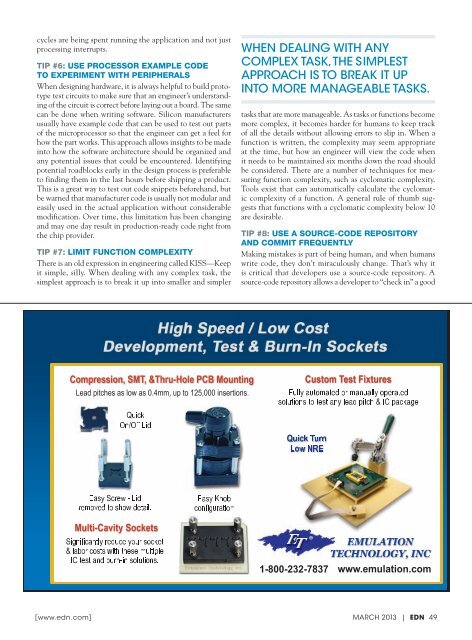201303.pdf 36567KB Mar 22 2013 09:11:22 PM
201303.pdf 36567KB Mar 22 2013 09:11:22 PM
201303.pdf 36567KB Mar 22 2013 09:11:22 PM
Create successful ePaper yourself
Turn your PDF publications into a flip-book with our unique Google optimized e-Paper software.
cycles are being spent running the application and not just<br />
processing interrupts.<br />
Tip #6: Use processor example code<br />
To experimenT wiTh peripherals<br />
When designing hardware, it is always helpful to build prototype<br />
test circuits to make sure that an engineer’s understanding<br />
of the circuit is correct before laying out a board. The same<br />
can be done when writing software. Silicon manufacturers<br />
usually have example code that can be used to test out parts<br />
of the microprocessor so that the engineer can get a feel for<br />
how the part works. This approach allows insights to be made<br />
into how the software architecture should be organized and<br />
any potential issues that could be encountered. Identifying<br />
potential roadblocks early in the design process is preferable<br />
to finding them in the last hours before shipping a product.<br />
This is a great way to test out code snippets beforehand, but<br />
be warned that manufacturer code is usually not modular and<br />
easily used in the actual application without considerable<br />
modification. Over time, this limitation has been changing<br />
and may one day result in production-ready code right from<br />
the chip provider.<br />
Tip #7: limiT fUncTion complexiTy<br />
There is an old expression in engineering called KISS—Keep<br />
it simple, silly. When dealing with any complex task, the<br />
simplest approach is to break it up into smaller and simpler<br />
When dealing With any<br />
complex task, the simplest<br />
approach is to break it up<br />
into more manageable tasks.<br />
tasks that are more manageable. As tasks or functions become<br />
more complex, it becomes harder for humans to keep track<br />
of all the details without allowing errors to slip in. When a<br />
function is written, the complexity may seem appropriate<br />
at the time, but how an engineer will view the code when<br />
it needs to be maintained six months down the road should<br />
be considered. There are a number of techniques for measuring<br />
function complexity, such as cyclomatic complexity.<br />
Tools exist that can automatically calculate the cyclomatic<br />
complexity of a function. A general rule of thumb suggests<br />
that functions with a cyclomatic complexity below 10<br />
are desirable.<br />
Tip #8: Use a soUrce-code reposiTory<br />
and commiT freqUenTly<br />
Making mistakes is part of being human, and when humans<br />
write code, they don’t miraculously change. That’s why it<br />
is critical that developers use a source-code repository. A<br />
source-code repository allows a developer to “check in” a good<br />
Compression, SMT, &Thru-Hole PCB Mounting<br />
Lead pitches as low as 0.4mm, up to 125,000 insertions.<br />
Quick<br />
On/Off Lid<br />
Custom Test Fixtures<br />
Fully automated or manually operated<br />
solutions to test any lead pitch & IC package<br />
Quick Turn<br />
Low NRE<br />
Easy Screw - Lid<br />
removed to show detail.<br />
Easy Knob<br />
configuration<br />
Multi-Cavity Sockets<br />
Significantly reduce your socket<br />
& labor costs with these multiple<br />
IC test and burn-in solutions.<br />
EMULATION<br />
TECHNOLOGY, INC<br />
1-800-232-7837 www.emulation.com<br />
[ www.edn.com ] <strong>Mar</strong>ch <strong>2013</strong> | EDN 49






![[270].pdf 37407KB Sep 02 2010 09:55:57 AM - ElectronicsAndBooks](https://img.yumpu.com/50350834/1/185x260/270pdf-37407kb-sep-02-2010-095557-am-electronicsandbooks.jpg?quality=85)
![draaien, A Viruly 1935 OCR c20130324 [320]. - ElectronicsAndBooks](https://img.yumpu.com/49957773/1/190x252/draaien-a-viruly-1935-ocr-c20130324-320-electronicsandbooks.jpg?quality=85)



![20051110 c20051031 [105].pdf 35001KB Feb 18 2009 08:46:32 PM](https://img.yumpu.com/48687202/1/190x253/20051110-c20051031-105pdf-35001kb-feb-18-2009-084632-pm.jpg?quality=85)





